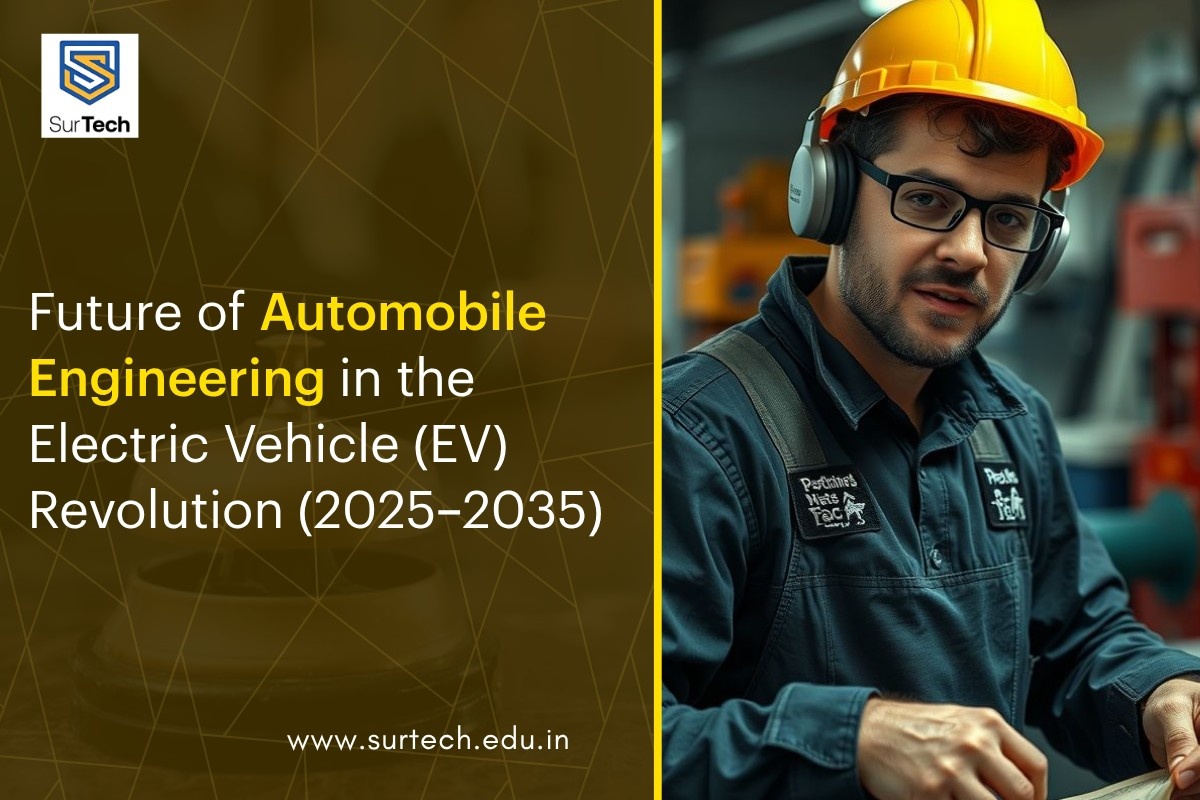
The decade from 2025 to 2035 will not merely be an era of incremental change for the automotive world — it will be a wholesale reinvention. What was once the realm of mechanical systems and internal-combustion mastery is now an interdisciplinary theatre where power electronics, battery chemistry, software architecture and systems integration take centre stage. For students and educators whether pursuing a B.Tech in automobile engineering or transitioning from Mechanical Engineering — the opportunity is enormous: the automobile engineer of 2030 will be as comfortable with embedded control code and battery-pack thermal maps as with stress analysis and chassis kinematics.
Why the EV era is accelerating (and what that means for engineers)
Global market signals are unambiguous. Electric car sales surged in recent years (reaching the tens of millions globally) and show sustained double-digit growth, while public charging infrastructure and policy support are expanding rapidly. This structural shift means automakers and suppliers are investing heavily in EV platforms, battery manufacturing and electrified powertrains — creating demand for engineers who can work across electrical, thermal, software and systems domains.
A second pivot is the rise of vehicle software and electronics as the primary value pool in modern cars. Forecasts show that automotive software and electronics will be a massive and fast-growing market through 2030 — demanding engineers fluent in systems thinking, control algorithms, and the secure integration of electronics into the vehicle architecture. In short: the centre of gravity in automobile engineering is moving from metal and machining to code, signals and chemistry.
The technical skills that will define employability (2025–2035)
Students studying automobile engineering today must therefore layer new capabilities on top of classical mechanical fundamentals:
-
Battery systems engineering: cell chemistry, pack architecture, thermal management and battery management systems (BMS).
-
Power electronics & electric motors: inverter design, motor control, high-voltage safety and reliability.
-
Embedded systems & software: MATLAB/Simulink, embedded C/C++, AUTOSAR, CAN/CAN-FD, over-the-air update architectures and cybersecurity basics.
-
Systems integration & testing: virtual validation, HIL/SIL, vehicle-level validation and functional safety (ISO 26262).
-
Vehicle-level modelling & CAE: multi-physics simulation (thermal, structural, electromagnetic) and digital twins to compress development cycles.
-
Sustainability and materials: recycling pathways, second-life battery strategies and lightweight materials selection.
Training that blends lab experience, project-based learning and industry internships will graduate engineers who can design, prototype and validate EV systems end-to-end. Skills lists from industry training providers show clear emphasis on powertrain controls, battery engineering and systems integration as high-priority competencies.
Where the jobs will be — and which disciplines will hire
From OEMs and Tier-1 suppliers to battery manufacturers, charging-network companies and mobility-software firms, the hiring spectrum is wide. Roles range from battery-system engineers and motor designers to controls engineers, test engineers, and automotive software developers. The expansion of charging infrastructure and grid integration also opens opportunities in energy systems and smart-charging engineering. Quarterly industry reviews show BEV sales and production accelerating in 2024–2025, which directly translates into hiring waves across design, manufacturing and software functions.
Research frontiers (why 2025–2035 is special)
The next ten years will see battery technologies move from lab curiosities to commercial scale. Advances in cell energy density, fast-charging chemistry and nascent solid-state cells promise higher ranges and shorter charge times — factors that will reshape vehicle packaging, safety standards and thermal management requirements. Engineers who understand the implications of evolving battery chemistries on system design will be uniquely valuable. Concurrently, the integration of artificial intelligence into vehicle systems — for energy optimisation, predictive maintenance and driver assistance — will reward engineers who can translate data-driven models into robust, certifiable features.
What this means for curriculum and for students (B.Tech & beyond)
Traditional syllabi in automobile engineering and Mechanical Engineering remain essential — dynamics, materials, thermodynamics and manufacturing will always matter — but they must be augmented with targeted coursework and labs in: electric drives, power electronics, battery engineering, embedded systems, and vehicle software architectures. Interdisciplinary projects (battery pack design, EV powertrain retrofit, charging-station integration) provide practical experience that classroom lectures cannot.
For students considering studies in automobile engineering (B.Tech in automobile engineering), elective choices, industry internships and capstone projects focused on EV topics will be decisive career differentiators.
Why institute choice matters: the SURTECH proposition
In a landscape where practical exposure is everything, an engineering college’s lab facilities, industry partnerships and curriculum agility determine the real value of a degree. SURTECH positions itself (as an institution committed to future-ready automobile engineering education) to bridge the theory–industry gap: modular EV labs, dedicated battery-systems workshops, power-electronics benches, and partnerships for internships with EV OEMs and Tier-1 suppliers. SURTECH’s pedagogical emphasis on hands-on projects, industry-aligned courses and placement support is tailored to produce engineers who can step into EV design, testing, and software roles from day one. For aspirants in Kolkata and beyond looking for an Engineering College in Kolkata offering strong automobile engineering pathways, SURTECH’s combination of Mechanical Engineering fundamentals with dedicated EV modules and industry tie-ups makes it a compelling option — particularly for students seeking a B.Tech in automobile engineering that is tuned to 2025–2035 industry realities.
Career road map
-
Build a strong mechanical foundation, then add power-electronics, battery, and software skills.
-
Seek internships and projects with EV focus (battery pack, inverter, BMS, charging systems).
-
Prioritise universities/colleges that offer EV labs, industry collaborations and placement pipelines.
-
Keep learning: battery chemistries, functional safety (ISO 26262), and embedded systems skills will pay off.
The EV revolution is not an abstract trend — it is the structural future of automobile engineering. For students, educators and institutes alike, 2025–2035 is the decisive decade to retool curricula, deepen industry partnerships, and produce engineers who can build the vehicles, batteries and software that will define mobility for generations to come.
